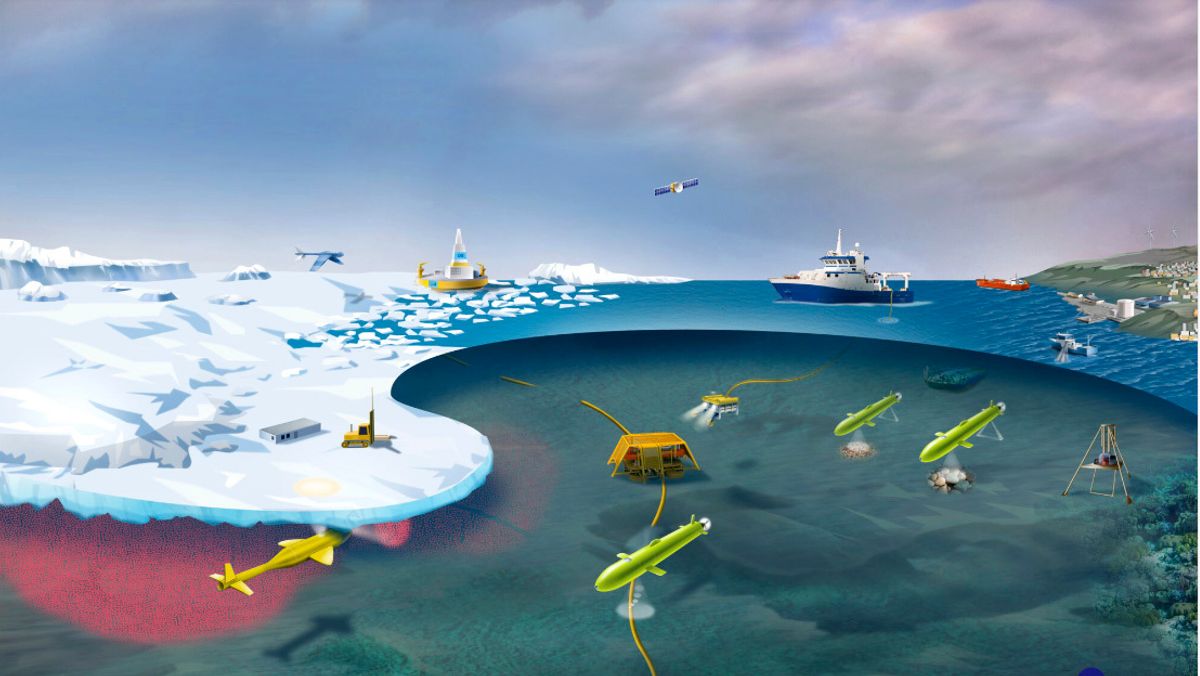In recent years, research institutions from Norway and many other countries have collected large amounts of data from the northern sea regions. There is great interest in accessing this information. Those who sit on such data and have the power to use it will have a lot of power in value creation, management and security. Data flows will increase dramatically with new technology, and the currently unsettled question is how this information should be managed in the best possible way.
Amos Research Environment – NTNU’s Center for Autonomous Marine Operations and Systems in collaboration with partners has developed methods and technologies that can monitor large marine areas in the North.
Huge amounts of data
This technology consists of robots and unmanned ships for use underwater and on the surface of the sea, in addition to small satellites and drones. The vehicle is equipped, among other things, with acoustic and optical sensors, such as hyperspectral cameras.
By combining all these techniques, the state of the oceans and their changes can be observed over areas ranging from a few centimeters to thousands of square kilometers – and over timescales ranging from seconds to decades. Together this makes up one Surveillance pyramid Which can collect huge amounts of data.

This data provides important information about climate change, biodiversity and the health status of the sea – as well as about human activity and ships in marine areas.
Naturally, such data also has great military, strategic and geopolitical importance.
Racing for the northern regions
With a warmer climate, the northern regions will become more important in the coming years. Here we clearly take the pulse of the planet’s health. With ice-free seas to the north, we are on our way from a white Arctic sea to a blue Arctic sea with increased human activity, a high probability of loss of species diversity, potential changes in ocean circulation, and accelerating global warming.
We also see changes in the region’s commercial value and geopolitical interest. Presence, knowledge and cooperation among allies will be crucial to asserting sovereignty and control over increasingly large and increasingly ice-free maritime areas.
In line with the rapid development of information and communications technology, the surveillance pyramid can be expanded and adapted more quickly and at much lower costs than traditional solutions based on ships, aircraft and satellites.
Additionally, in most cases they have lower carbon emissions than traditional solutions.
Because lower costs make technology available to more people, we can call this the “democratization” of sea, air and space where new actors can operate. Unfortunately, increased availability also leads to increased vulnerability to sabotage on offshore infrastructure. This must also be dealt with.
Amazon and Google are in the field
Many people are interested in obtaining information about marine areas. We ask who will own, ensure quality, make available and manage the large amount of data collected through research, management and industry.
In the European Union, work is underway to create digital twins of the oceans under the auspices of Esa Digital Twin Earth, Emodnet and projects such as Illiad. The owners of the world’s largest technology companies, such as Amazon, Bezos’ Earth Fund, and Google, are also in the field with ambitions for ocean data. Already collected and submitted Google Earth Outreach Data on fisheries.
In Norway, HUB Ocean and REV Ocean are working to establish a global ocean data centre.
Marine data should also, as much as possible, be shared globally, which is already being done under the auspices of the European Union, the European Space Agency and NASA, for example.
Norway, as a leading coastal state, must take responsibility
We believe that the Norwegian authorities must take responsibility and increase the level of ambition in terms of marine presence and data to ensure good resource management and value creation based on this data.
We can’t wait for foreign players to do the work for us, putting ourselves in the back seat. Mobilization for more systematic collection and management of ocean data should take place within the framework of international cooperation between public and private actors.
The investment in the Norwegian Center for Ocean Technology with Fjordlab in Trondheim is an important step towards building national capacity for ocean data collection. Both with the aim of monitoring the sea and enabling Norwegian industry to develop the technology that will be needed.
The Marine Technology Center should be supported by establishing a national research infrastructure for small satellites, drones and autonomous ships. An important part of this investment will be the realization of a national marine data strategy.
We do not have enough time to achieve this in a world suffering from increasing geopolitical tensions on top of climate and natural crises. Here is an international race that Norway cannot afford to lose, given the presence of socially important infrastructure at sea in addition to important marine resources.
Year no for marine data
Another aspect of research data is that it initially takes a long time to analyze and make it available as a basis for decision making in almost real time. For authorities, researchers and companies working on sea-related issues, it is important to have access to new data as quickly as possible. Not least is data that provides information about changes in climate, natural diversity and activities that occur at sea.
We want to create a national mobilization to create a yr.no model with real-time data of what is happening in marine areas – yr.no can provide real-time information and weather reporting on oceanic conditions such as current conditions and weather conditions. Temperature, salinity and sea health – such as oxygen content and algae blooms. NTNU is ready to contribute with multidisciplinary teams of experts.

“Web specialist. Lifelong zombie maven. Coffee ninja. Hipster-friendly analyst.”




